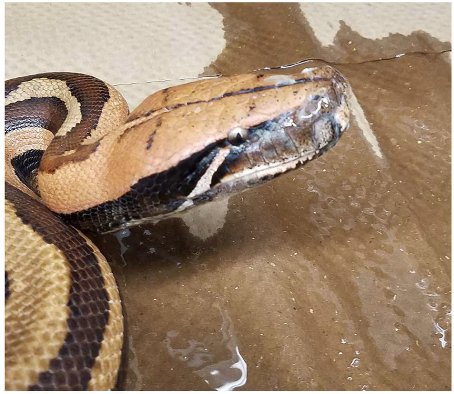Abstract
The aim of this study of serpentovirus infection in captive snakes was to assess the susceptibility of different types of snakes to infection and disease, to survey viral genetic diversity, and to evaluate management practices that may limit infection and disease. Antemortem oral swabs were collected from 639 snakes from 12 US collections, including 62 species, 28 genera, and 6 families: Pythonidae (N = 414 snakes; pythons were overrepresented in the sample population), Boidae (79), Colubridae (116), Lamprophiidae (4), Elapidae (12), and Viperidae (14). Infection was more common in pythons (38%; 95% CI: 33.1-42.4%), and in boas (10%; 95% CI: 5.2-18.7%) than in colubrids (0.9%, 95% CI: <0.01-4.7%); infection was not detected in other snake families (lamprophiids 0/4, 95% CI: 0-49%; elapids 0/12, 95% CI: 0-24.2%; and vipers 0/14, 95% CI: 0-21.5%), but more of these snakes need to be tested to confirm these findings. Clinical signs of respiratory disease were common in infected pythons (85 of 144). Respiratory signs were only observed in 1 of 8 infected boas and were absent in the single infected colubrid. Divergent serpentoviruses were detected in pythons, boas, and colubrids, suggesting that different serpentoviruses might vary in their ability to infect snakes of different families. Older snakes were more likely to be infected than younger snakes (p-value < 0.001) but males and females were equally likely to be infected (female prevalence: 23.4%, 95% CI 18.7-28.9%; male prevalence: 23.5%, 95% CI 18-30.1%; p-value = 0.144). Neither age (p-value = 0.32) nor sex (p-value = 0.06) was statistically associated with disease severity. Longitudinal sampling of pythons in a single collection over 28 months revealed serpentovirus infection is persistent, and viral clearance was not observed. In this collection, infection was associated with significantly increased rates of mortality (p-value = 0.001) with death of 75% of infected pythons and no uninfected pythons over this period. Offspring of infected parents were followed: vertical transmission either does not occur or occurs with a much lower efficiency than horizontal transmission. Overall, these findings confirm that serpentoviruses pose a significant threat to the health of captive python populations and can cause infection in boa and colubrid species.
